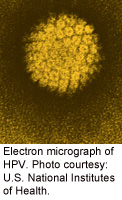- Skip Storing This Everyday Product in the Fridge Door
- Green Tea + B3 Pairing May Boost Brain Health
- Navigating Your Midlife Crisis: Embracing New Possibilities
- City Raccoons Showing Signs of Domestication
- Mapping the Exposome: Science Broadens Focus to Environmental Disease Triggers
- One Week Less on Social Media Linked to Better Mental Health
- Your Brain Changes in Stages as You Age, Study Finds
- Some Suicide Victims Show No Typical Warning Signs, Study Finds
- ByHeart Formula Faces Lawsuits After Babies Sickened With Botulism
- Switch to Vegan Diet Could Cut Your Greenhouse Gas Emissions in Half
HPV Vaccine Rates Lagging in Southern U.S., Study Finds


TUESDAY, Nov. 5Young women living in the South have much lower rates of vaccination against the human papillomavirus (HPV) than women in other parts of the United States, a new study reveals.
The findings are especially alarming because rates of cervical cancer — which is caused almost exclusively by HPV — are higher in the southern U.S. than in other regions, according to researchers at the University of Texas Medical Branch at Galveston (UTMB).
The study authors analyzed data collected between 2008 and 2010 from 12 states in four regions: the Northeast (Connecticut, Massachusetts, Pennsylvania, Rhode Island); the Midwest (Kansas, Minnesota, Nebraska); the West (Wyoming); and the South (Delaware, Oklahoma, Texas, West Virginia).
About 28 percent of women in all these states began the vaccine regimen and 17 percent completed the three-dose series over the three-year study period. HPV vaccine initiation and completion rates, respectively, were 37 percent and 23 percent in the Northeast; nearly 29 percent and about 19 percent in the Midwest/West; and 14 percent and 6 percent in the South, the findings showed.
Among people starting the vaccine regimen, rates in the Northeast rose from nearly 21 percent in 2008 to 44 percent in 2010. In the Midwest/West, the initiation rates dropped from just over 36 percent in 2008 to 29 percent in 2010. Initiation rates were consistently lowest in the South, at 14 percent in 2008 and 22.5 percent in 2010.
White women were more likely than those in other racial/ethnic groups to begin and complete the vaccine series, according to the study published in the Nov. 12 online edition of the journal Vaccine.
“If a lower rate of HPV vaccine uptake in the South persists, it could contribute to the national burden of cervical cancer in the long run,” Dr. Abbey Berenson, director of UTMB’s Center for Interdisciplinary Research in Women’s Health, said in a university news release.
To lower rates of HPV-related diseases, doctors should do more to encourage their patients to get vaccinated, Berenson suggested. More money spent on vaccine programs and educating patients could also help, she added.
The regional disparities in HPV vaccination could be due to several factors, including differences in income, education and insurance coverage, the researchers said.
About 79 million Americans are currently infected with HPV, and most sexually active people will be infected with at least one type of HPV at some point in their lives. The virus is responsible for nearly all cases of cervical cancer, which kills more than 4,000 American women a year. Half of those deaths occur in the South.
HPV is also associated with genital warts and cancers of the mouth and throat, as well as vulvar, vaginal, penile and anal cancers.
More information
The U.S. Centers for Disease Control and Prevention has more about HPV vaccination.
Source: HealthDay
Copyright © 2025 HealthDay. All rights reserved.










